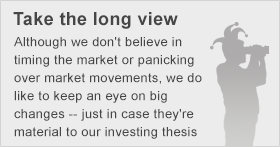Filed under: Investing
Check out what dropped the Dow Jones Industrial Average all five trading days last week -- including its hangover-inducing 231 point loss on Thursday.
1. Stock market winners ...
It must almost be wedding season, because home appliance registry legend Willams-Sonoma hit a 52-week high after holiday earnings outperformed other retailers. Dick's Sporting Goods sold plenty of sports gear to Olympic enthusiasts over the holidays, boosting profits by 6.9%. And Krispy Kreme treated investors to a surprise $14.8 million profit ($10 million more than last year for sweet-toothed investors keeping track).
2. ... And stock market losers (airline stocks)
The big pain all week was with airline stocks (and not because of the Malaysia Airlines mystery) -- Boeing dipped after reports of cracks on 40 of its fancy new 787 Dreamliners. Meanwhile a 787 was forced to make an emergency landing at Honolulu (kudos to the pilot for finding Hawaii Island in the middle of a pretty big body of water). Boeing's invested years of blood, sweat, and tears (as well as over $30 billion) to get the new generation of jumbo jet onto the tarmac. The Dreamliner has been nothing but a nightmare for Boeing, and this week's disturbing cracks on the wings and e-landing is not what it needed. Boeing stock dropped a total 4.2% this week.
Meanwhile American Airlines fell after ending a once-cool partnership with JetBlue over sharing frequent flyer miles. Now the American/US Airways merger is complete, American is ending ties with NYC's hipster airline. It's all about competition now, but investors were disappointed to see the consumer-friendly deal killed. American made an "emergency landing" of its own, by falling 6.9% on the week.
3. Plenty of corporate drama
Amazon.com freaked out 20 million of its most hardcore online shopping enthusiasts ("Amazon.com: it's a lifestyle") by raising its Amazon Prime free-shipping membership from $79 to $99 a year -- but Wall Street applauded the move as a sign of profit-capturing by management. Amazon managed to climb 0.5% as the rest of the market tanked.
And Herbalife fell more than 10% on the week after activist investor/hater Bill Ackman's successful lobbying efforts successfully resulted in an investigation by the Federal Trade Commission. The question is whether Herbalife's unique business model of siging up salespeople to buy and push their dietary drink products to customers is savvy, or sleazy. In late 2012 Ackman bet over $1 billion via a "short sale" that the company would fail. But major investments from Carl Icahn and other celeb investors have pumped ths tock to record highs. Icahn lost this week and Ackman finally got some relief on his losing bet. The FTC is investigating the controversial energy beverage/lifestyle firm as a straight up pyramid scheme.
4. Deals, mergers, and acquisitions, baby
Smooth-talking suit-sales firm Men's Wearhouse added to its wardrobe, purchasing smaller rival Jos. A. Bank for $1.8 billion after months of both companies trying to outbid the other (things got awkward). And JetBlue sold the TV-technology that made it famous at 35,000 feet for $400 million to a French aeronautics firm.
5. Chinese econ data tasted
The world's second-largest economy released three key econ reports that will make you break your chopsticks over your leg. First, Chinese exports shockingly dropped 18.1% from a year ago, creating its first significant trade deficit since early '12 (economists blamed the country's extended New Year's festivities, but Wall Street panicked on signs of reduced global demand). While China's industrial production rose 8.6% and retail sales gained 11.8% over the past two months, both figures were below analysts' expectations. The year of the horse hasn't been kind so far.
6. Ukraine's still a-weighing on investors
The geopolitical crisis in shaken Ukraine developed further over the week, as Crimeans moved to vote over the weekend about whether to break away and join Team Russia. The U.S. and EU haven't liked Russian President Putin's support of annexing the strategically located peninsula and have begun threatening a harsher economic response. Wall Street remained wary all week as the big boys battle out diplomacy like a mid-ice, hockey-style fight.
MarketSnacks this week:
- Monday: New Yotk Empire State Manufacturing; earnings (Perry Ellis)
- Tuesday: 2-day Federal Reserve policy meeting begins; earnings (Oracle)
- Wednesday: Fed Chairwoman Janet Yellen speaks; earnings (FedEx)
- Thursday: Existing home sales; earnings (Nike, Swatch)
- Friday: Atlanta Fed biz expectations
MarketSnacks Fact of the Day: For the upcoming World Cup in Brazil, the previously approved $2.8 billion budget for 12 stadiums has been raised 285% to more than $8 billion.
Our top stock for 2014
There's a huge difference between a good stock and a stock that can make you rich. The Motley Fool's chief investment officer has selected his No. 1 stock for 2014, and it's one of those stocks that could make you rich. You can find out which stock it is in the special free report "The Motley Fool's Top Stock for 2014." Just click here to access the report and find out the name of this under-the-radar company.
The article 5 Losing Days for Dow Last Week, Amazon Defies Market, and Herbalife Tanks originally appeared on Fool.com.
Jack Kramer and Nick Martell have no position in any stocks mentioned. The Motley Fool recommends Amazon.com, FedEx, and Nike; owns shares of Amazon.com, Nike, Oracle, and Perry Ellis; and has options on Herbalife. Try any of our Foolish newsletter services free for 30 days. We Fools don't all hold the same opinions, but we all believe that considering a diverse range of insights makes us better investors. The Motley Fool has a disclosure policy.Copyright © 1995 - 2014 The Motley Fool, LLC. All rights reserved. The Motley Fool has a disclosure policy.
Read | Permalink | Email this | Linking Blogs | Comments




















